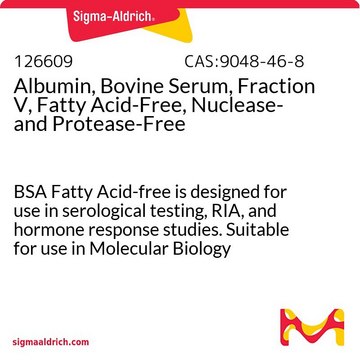12660
Albumin, Bovine Serum, Fraction V, Modified Cohn, pH 5.2
Synonyme(s) :
Albumin, Bovine Serum, Fraction V, Modified Cohn, pH 5.2
About This Item
Produits recommandés
Pureté
≥96% (SDS-PAGE)
Forme
solid
Fabricant/nom de marque
Calbiochem®
Conditions de stockage
OK to freeze
Impuretés
≤5% Moisture
Couleur
off-white
Solubilité
0.15 M sodium chloride: 10 mg/mL
Traces de cations
heavy metals: ≤50 ppm
Conditions d'expédition
ambient
Température de stockage
2-8°C
Description générale
Application
Actions biochimiques/physiologiques
Avertissement
Reconstitution
Informations légales
Code de la classe de stockage
11 - Combustible Solids
Classe de danger pour l'eau (WGK)
WGK 3
Point d'éclair (°F)
Not applicable
Point d'éclair (°C)
Not applicable
Certificats d'analyse (COA)
Recherchez un Certificats d'analyse (COA) en saisissant le numéro de lot du produit. Les numéros de lot figurent sur l'étiquette du produit après les mots "Lot" ou "Batch".
Déjà en possession de ce produit ?
Retrouvez la documentation relative aux produits que vous avez récemment achetés dans la Bibliothèque de documents.
Les clients ont également consulté
Notre équipe de scientifiques dispose d'une expérience dans tous les secteurs de la recherche, notamment en sciences de la vie, science des matériaux, synthèse chimique, chromatographie, analyse et dans de nombreux autres domaines..
Contacter notre Service technique





